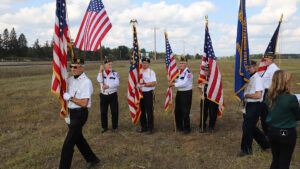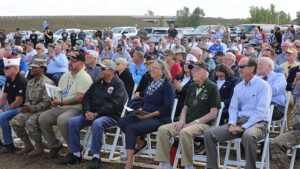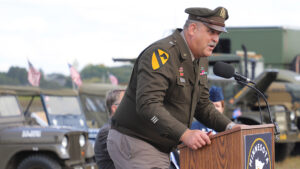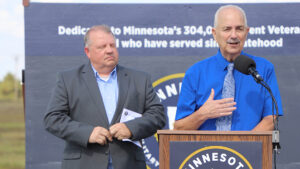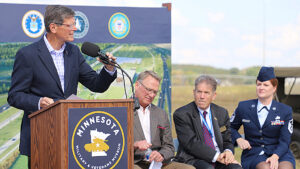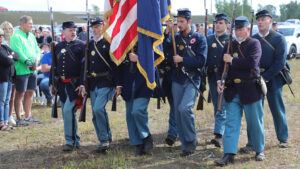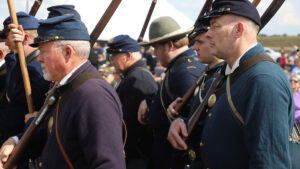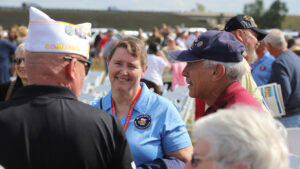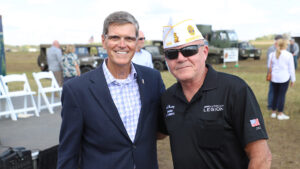$32 million Minnesota Military & Veterans Museum breaks ground
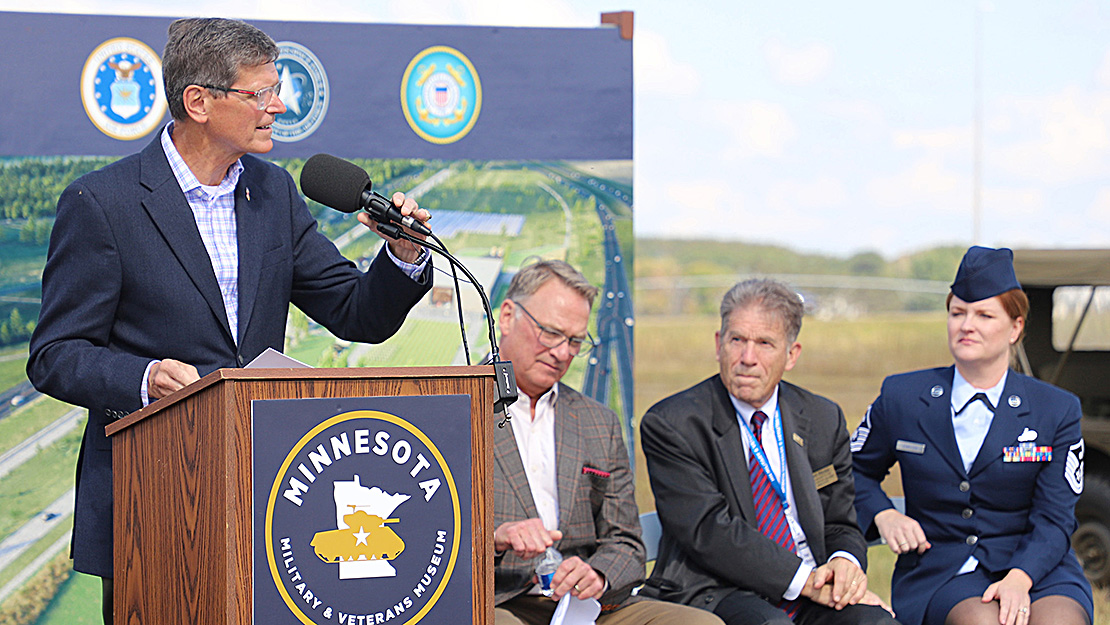
CAMP RIPLEY — With about 300 people in attendance and a World War II-era Navy bulldozer at the ready, the Minnesota Military & Veterans Museum broke ground Sept. 17 on its new site outside of Camp Ripley.
The new $32 million museum structure will have 40,000 square feet of space on a 30-acre parcel along Minnesota Highway 371, east of the Little Falls State Veterans Cemetery, which itself is just east of Camp Ripley.
After a color guard comprising members of various veteran service organizations presented the colors, Brig. Gen. Lowell Kruse, assistant adjutant general of the Minnesota National Guard, said, “Those are the individuals we are highlighting in this museum.”
Kruse said the state of Minnesota founded Camp Ripley in 1929, named for the federal frontier installation Fort Ripley that had closed in 1877.
The Works Project Administration, between 1934 and 1942, constructed a 3,400-foot rock wall marking the cantonment’s main gate and south side. Kruse said this wall became the signature of Camp Ripley. The base was expanded in 1951 to 45,000 acres, and over time, it has crept up to its present 53,000 acres.
The 169-acre Little Falls State Veterans Cemetery opened in June 1994, with a similar-looking rock wall.
Kruse said the new museum, just like what happened with the cemetery, “will become part of the Camp Ripley family.”
The new museum grounds will feature the actual top part of a nuclear submarine poking out of the ground.
“I look forward to it in the winter when we will see the conning tower of the nuclear sub looking like it is in the Arctic coming out of the ice,” Kruse said.
The emcee for the groundbreaking was KSTP newscaster Kevin Doran, who noted his grandfather Tom Doran is buried at Little Falls State Veteran Cemetery.
The keynote speaker was retired four-star Gen. Joseph Votel, who grew up in St. Paul and was commander of U.S. Central Command from March 2016 to March 2019. Most veterans already know Centcom’s area of responsibility covers most of the Mideast, including Iraq and Afghanistan. Before Centcom, he commanded Special Operations, which covers the highly skilled components of each of the branches, such as Delta Force, Rangers, SEALs, 24th Special Tactics, etc.
As a child traveling in a car with many siblings, Votel’s father, Henry, would explain the National Guard and, of course, mention the tank along the side of Highway 371.
“The jockeying in the back seat to get the best view began,” Votel said.
The first time he came to Camp Ripley was to witness his older brother graduate from the Minnesota Military Academy in 1970 and become a second lieutenant. (The academy’s name changed in the mid-2000s to 175th Regiment Regional Training Institute.) His brother’s participation in the Armed Forces influenced his career choice. Votel spent 39 years as an officer.
“Minnesota has an extraordinarily rich military history,” Votel said.
The retired general mentioned Minnesotans were the first to answer the call of President Abraham Lincoln at the onset of the Civil War and fought to free 4.2 million enslaved people. Minnesota was home to the last surviving Civil War veteran — Albert Woolson of Duluth, who died in 1956 at age 106.
World War II veteran and former Gov. Al Quie died in August, Votel noted. Quie was a Navy pilot. His grandfather was a Civil War veteran.
“In the very early hours of Dec. 7, 1941, Minnesota Naval Reservists aboard the USS Ward fired the first American shots of World War II well in advance of the Japanese attack on Pearl Harbor,” he said.
A month later, Milburn Henke of Hutchinson, as part of the 34th “Red Bull” Infantry Division, was the first U.S. soldier to step foot in Europe in the war, arriving in Belfast, Ireland, on Jan. 26, 1942.
Minnesotans fought at Anzio, stormed the beaches at Normandy, liberated concentration camps in Europe and raised the first flag at Iwo Jima. Helping to raise that flag was Marine Cpl. Chuck Lindberg, who grew up in North Dakota but resided in Richfield following the war. He is buried at Fort Snelling National Cemetery.
One Minnesotan served in three wars and went on to become the highest-ranking officer in the U.S. Armed Forces. Gen. John Vessey of Minneapolis served as chairman of the Joint Chiefs of Staff from 1982 to 1985 and is buried at Little Falls State Veterans Cemetery.
Five Medal of Honor recipients from the Vietnam War, he said, have ties to Minnesota.
Votel then spoke of Pipestone’s Max Beilke, who was listed as the last American soldier to leave Saigon on March 29, 1973. He was among the first killed in the Global War on Terrorism. He was at a meeting in the Pentagon on Sept. 11, 2001, when American Airlines Flight 77 struck the building. The new VA clinic in Alexandria is named for him.
Bloomington’s Tom Burnett was aboard United Flight 93, and after calling his wife during the hijacking, he realized the terrorist’s suicide mission and helped lead the passengers’ efforts to revolt.
“More than 400 members of the Minnesota National Guard were rushed to the Kabul Airport in August 2021 to provide essential security that finally enabled evacuations of our allies to begin and to bring an end to America’s longest war,” Votel said.
Minnesota is home to many more stories like these, like Farmington’s Cpl. Ben Kopp, who willingly advanced on enemy fire to protect his team of Rangers in Afghanistan and was mortally wounded.
“That is why this groundbreaking is so important. The stories that are told within the walls of the museum that will stand on this spot will teach and inspire the time-tested values of love of country and service to fellow man — values that we know are weaved into the fabric of our land, our lakes and our people,” Votel said.
Construction is slated to begin in spring 2024. The state Legislature provided $32 million to design and construct the facility. The museum’s board of directors is more than halfway toward its private fundraising goal of $10 million to outfit the gallery spaces, classrooms and collections.
New Prague Post 45 Commander Linda Dvorak is on the museum board and is mailing out a request letter to Legion posts and units with charitable gambling. If you wish to request the letter via email, contact her at [email protected].
To become a member of the museum or make an individual donation, visit its website at mnmilitarymuseum.org to see donation levels. For a basic membership, send $30 to Minnesota Military Museum, Camp Ripley, 15000 Hwy 115, Little Falls, MN 56345.
At 7 p.m. Oct. 23, the museum hosts a virtual event called “From the Ground Up: The Making of a Veterans Museum.” Visit mnvetmuseum.org and click on “Events” to find the online registration.




